The Veterinary Micro-fibre Endoscope Market is estimated to be valued at USD 577.8 million in 2025 and is projected to reach USD 1190.9 million by 2035, registering a compound annual growth rate (CAGR) of 7.5% over the forecast period.
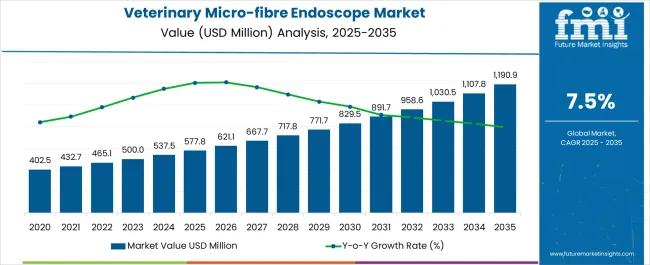
| Metric | Value |
|---|---|
| Veterinary Micro-fibre Endoscope Market Estimated Value in (2025 E) | USD 577.8 million |
| Veterinary Micro-fibre Endoscope Market Forecast Value in (2035 F) | USD 1190.9 million |
| Forecast CAGR (2025 to 2035) | 7.5% |
The Veterinary Micro-fibre Endoscope market is experiencing significant growth, driven by the increasing adoption of minimally invasive diagnostic procedures in veterinary medicine. Growing awareness among veterinarians about the benefits of micro-fibre endoscopes, including enhanced image clarity, flexibility, and reduced tissue trauma, is contributing to market expansion. The rising prevalence of companion animals and the increasing focus on animal health and welfare are further supporting demand.
Technological advancements, such as improved heat-resistance, higher resolution imaging, and compatibility with sterilization protocols, are enabling more precise diagnostics and treatment outcomes. Veterinary hospitals and specialized clinics are increasingly investing in advanced endoscopic equipment to improve procedural efficiency and patient recovery times. Regulatory standards and quality certifications for medical devices in veterinary applications are also fostering market adoption.
As veterinarians prioritize minimally invasive interventions, and animal healthcare infrastructure continues to expand globally, the market is positioned for sustained growth Continuous innovation in micro-fibre optics and imaging technologies is expected to further strengthen market momentum over the coming years.
The veterinary micro-fibre endoscope market is segmented by product type, end user, and geographic regions. By product type, veterinary micro-fibre endoscope market is divided into Heat-Resistant Veterinary Micro-Fibre Endoscopes, Waterproof Veterinary Micro-Fibre Endoscopes, and Veterinary Micro-Fibre Micro-Fibre Endoscopes.
In terms of end user, veterinary micro-fibre endoscope market is classified into Specialized Veterinary Clinics, Veterinary Hospital, and Others. Regionally, the veterinary micro-fibre endoscope industry is classified into North America, Latin America, Western Europe, Eastern Europe, Balkan & Baltic Countries, Russia & Belarus, Central Asia, East Asia, South Asia & Pacific, and the Middle East & Africa.
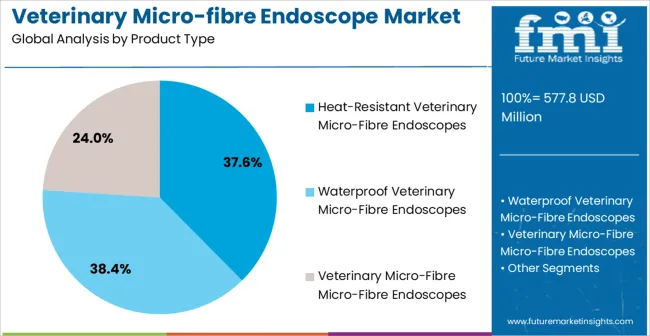
The heat-resistant veterinary micro-fibre endoscopes segment is projected to hold 37.6% of the market revenue in 2025, establishing it as the leading product type. Growth in this segment is being driven by the increasing demand for endoscopes that maintain durability and performance under repeated sterilization and high-temperature conditions. These endoscopes offer superior image clarity, flexibility, and reliability, which are essential for accurate diagnostics in minimally invasive procedures.
Veterinary practitioners value the ability to perform a wide range of procedures without equipment degradation, reducing replacement costs and improving procedural efficiency. Enhanced heat resistance ensures compliance with sterilization standards, which is critical in specialized veterinary clinics handling multiple cases daily.
The segment is also supported by innovations in micro-fibre materials and optical engineering, which improve resolution and maneuverability As veterinarians continue to adopt minimally invasive techniques and prioritize long-lasting, high-performance instruments, heat-resistant micro-fibre endoscopes are expected to maintain their leading position and continue driving market growth.
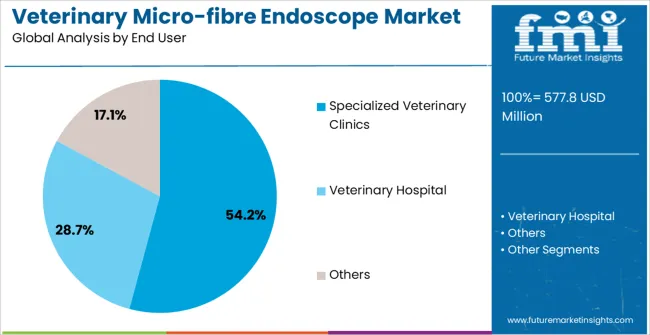
The specialized veterinary clinics segment is anticipated to account for 54.2% of the market revenue in 2025, making it the largest end-user category. Growth is being driven by the increasing use of advanced diagnostic and surgical procedures in these facilities, which require precise and high-performance endoscopic tools. Specialized clinics often handle complex cases, including small animal, equine, and exotic species, where minimally invasive procedures improve patient outcomes and reduce recovery times.
Investment in advanced equipment, including heat-resistant micro-fibre endoscopes, enables these clinics to maintain high standards of care and procedural efficiency. Additionally, the growing adoption of veterinary specialty services, combined with rising client expectations for minimally invasive treatment options, is further supporting market expansion.
The ability to integrate advanced imaging technologies and sterilization-compatible equipment ensures reliable, repeatable performance As specialized clinics continue to expand their capabilities and provide high-quality veterinary care, this end-user segment is expected to remain the primary driver of market growth, reinforced by technological advancements and increasing procedural adoption.
The veterinary micro-fibre endoscopes are the smallest endoscopes in the veterinary market that provide great flexibility in the diagnosis of diseases in upper respiratory and urinary tracts of most companion animals, including general endoscopy. These endoscopes allow the examiner to look into a body cavity or body organ in animals to gain diagnostic information about the organ which grossly evaluating an area of interest and help to obtain tissue for histopathologic estimation.
Veterinary micro endoscopes are flexible microscopes that are ideal for the inspection of minute holes or cavities. For the nonsurgical option for diagnosis and treatment of a variety of disease condition in animals, these versatile micro-fibre endoscopes are being used. The veterinary micro-fibre endoscopes are built-in illumination power handles that are easy to use for the user for better diagnosis or better view of the internal organ or cavity.
They are also available in Veterinary micro-fibre endoscope ides which provide an amazing image quality with focusing. Some veterinary micro-fibre endoscopes are high-performance fibre optic cable bundles which provide bright and illumination. Some veterinary endoscopes are heat-resistant up to 70°C and some are waterproof available in the market. Veterinary micro-fibre endoscopes are used to gain better view of internal organs for feeding tube replacement or stone removal.
These veterinary micro-fibre endoscopes are used in various endoscopy such as bronchoscopy, Colonoscopy, esophagoscopy, gastroduodenoscopy, urethrocystoscopy (for male dog), nasopharyngoscopy and tracheoscopy.
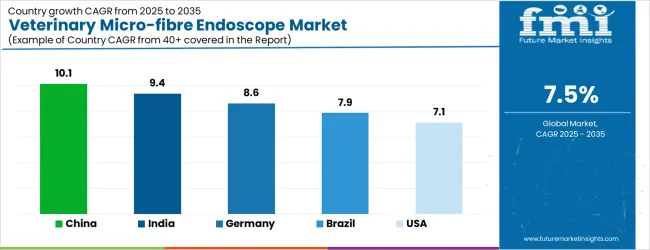
| Country | CAGR |
|---|---|
| China | 10.1% |
| India | 9.4% |
| Germany | 8.6% |
| Brazil | 7.9% |
| USA | 7.1% |
| UK | 6.4% |
| Japan | 5.6% |
The Veterinary Micro-fibre Endoscope Market is expected to register a CAGR of 7.5% during the forecast period, exhibiting varied country level momentum. China leads with the highest CAGR of 10.1%, followed by India at 9.4%. Developed markets such as Germany, France, and the UK continue to expand steadily, while the USA is likely to grow at consistent rates.
Japan posts the lowest CAGR at 5.6%, yet still underscores a broadly positive trajectory for the global Veterinary Micro-fibre Endoscope Market. In 2024, Germany held a dominant revenue in the Western Europe market and is expected to grow with a CAGR of 8.6%.
The USA Veterinary Micro-fibre Endoscope Market is estimated to be valued at USD 199.8 million in 2025 and is anticipated to reach a valuation of USD 199.8 million by 2035. Sales are projected to rise at a CAGR of 0.0% over the forecast period between 2025 and 2035. While Japan and South Korea markets are estimated to be valued at USD 29.7 million and USD 15.5 million respectively in 2025.
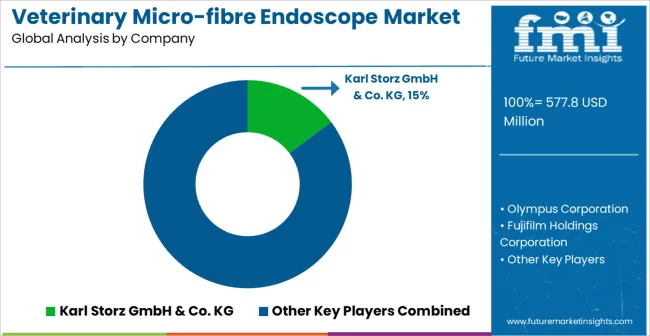
| Item | Value |
|---|---|
| Quantitative Units | USD 577.8 Million |
| Product Type | Heat-Resistant Veterinary Micro-Fibre Endoscopes, Waterproof Veterinary Micro-Fibre Endoscopes, and Veterinary Micro-Fibre Micro-Fibre Endoscopes |
| End User | Specialized Veterinary Clinics, Veterinary Hospital, and Others |
| Regions Covered | North America, Europe, Asia-Pacific, Latin America, Middle East & Africa |
| Country Covered | United States, Canada, Germany, France, United Kingdom, China, Japan, India, Brazil, South Africa |
| Key Companies Profiled | Karl Storz GmbH & Co. KG, Olympus Corporation, Fujifilm Holdings Corporation, Pentax Medical (HOYA Corporation), Richard Wolf GmbH, Stryker Corporation, Boston Scientific Corporation, Smith & Nephew plc, Medtronic plc, B. Braun Melsungen AG, Ethicon, Inc. (Johnson & Johnson), Conmed Corporation, Cook Medical, and EndoChoice, Inc. |
The global veterinary micro-fibre endoscope market is estimated to be valued at USD 577.8 million in 2025.
The market size for the veterinary micro-fibre endoscope market is projected to reach USD 1,190.9 million by 2035.
The veterinary micro-fibre endoscope market is expected to grow at a 7.5% CAGR between 2025 and 2035.
The key product types in veterinary micro-fibre endoscope market are heat-resistant veterinary micro-fibre endoscopes, waterproof veterinary micro-fibre endoscopes and veterinary micro-fibre micro-fibre endoscopes.
In terms of end user, specialized veterinary clinics segment to command 54.2% share in the veterinary micro-fibre endoscope market in 2025.






Our Research Products

The "Full Research Suite" delivers actionable market intel, deep dives on markets or technologies, so clients act faster, cut risk, and unlock growth.

The Leaderboard benchmarks and ranks top vendors, classifying them as Established Leaders, Leading Challengers, or Disruptors & Challengers.

Locates where complements amplify value and substitutes erode it, forecasting net impact by horizon

We deliver granular, decision-grade intel: market sizing, 5-year forecasts, pricing, adoption, usage, revenue, and operational KPIs—plus competitor tracking, regulation, and value chains—across 60 countries broadly.

Spot the shifts before they hit your P&L. We track inflection points, adoption curves, pricing moves, and ecosystem plays to show where demand is heading, why it is changing, and what to do next across high-growth markets and disruptive tech

Real-time reads of user behavior. We track shifting priorities, perceptions of today’s and next-gen services, and provider experience, then pace how fast tech moves from trial to adoption, blending buyer, consumer, and channel inputs with social signals (#WhySwitch, #UX).

Partner with our analyst team to build a custom report designed around your business priorities. From analysing market trends to assessing competitors or crafting bespoke datasets, we tailor insights to your needs.
Supplier Intelligence
Discovery & Profiling
Capacity & Footprint
Performance & Risk
Compliance & Governance
Commercial Readiness
Who Supplies Whom
Scorecards & Shortlists
Playbooks & Docs
Category Intelligence
Definition & Scope
Demand & Use Cases
Cost Drivers
Market Structure
Supply Chain Map
Trade & Policy
Operating Norms
Deliverables
Buyer Intelligence
Account Basics
Spend & Scope
Procurement Model
Vendor Requirements
Terms & Policies
Entry Strategy
Pain Points & Triggers
Outputs
Pricing Analysis
Benchmarks
Trends
Should-Cost
Indexation
Landed Cost
Commercial Terms
Deliverables
Brand Analysis
Positioning & Value Prop
Share & Presence
Customer Evidence
Go-to-Market
Digital & Reputation
Compliance & Trust
KPIs & Gaps
Outputs
Full Research Suite comprises of:
Market outlook & trends analysis
Interviews & case studies
Strategic recommendations
Vendor profiles & capabilities analysis
5-year forecasts
8 regions and 60+ country-level data splits
Market segment data splits
12 months of continuous data updates
DELIVERED AS:
PDF EXCEL ONLINE
Veterinary Endoscopes Market Insights - Trends, Applications & Forecast 2024 to 2034
Veterinary Point of Care Diagnostics Market Size and Share Forecast Outlook 2025 to 2035
Veterinary Allergy Diagnostics Market Size and Share Forecast Outlook 2025 to 2035
Veterinary TSE Testing Market Size and Share Forecast Outlook 2025 to 2035
Veterinary Dermatology Market Forecast Outlook 2025 to 2035
Veterinary Telemedicine Market Size and Share Forecast Outlook 2025 to 2035
Veterinary Dietary Supplements Market Size and Share Forecast Outlook 2025 to 2035
Veterinary Imaging Market Forecast and Outlook 2025 to 2035
Veterinary CRISPR-Based Detection Kits Market Size and Share Forecast Outlook 2025 to 2035
Veterinary Pregnancy Test Kit Market Forecast and Outlook 2025 to 2035
Veterinary X-Ray Illuminators Market Size and Share Forecast Outlook 2025 to 2035
Veterinary Scales Market Size and Share Forecast Outlook 2025 to 2035
Veterinary Grooming Aids Market Size and Share Forecast Outlook 2025 to 2035
Veterinary Faecal Filters Market Size and Share Forecast Outlook 2025 to 2035
Endoscope Protective Barrier Covers Market Size and Share Forecast Outlook 2025 to 2035
Veterinary Dental Equipment Market Size and Share Forecast Outlook 2025 to 2035
Veterinary Rapid Test Market Size and Share Forecast Outlook 2025 to 2035
Veterinary Therapeutic Diet Market Size and Share Forecast Outlook 2025 to 2035
Veterinary Glucometers Market Size and Share Forecast Outlook 2025 to 2035
Veterinary Pain Management Drugs Market Size and Share Forecast Outlook 2025 to 2035

Thank you!
You will receive an email from our Business Development Manager. Please be sure to check your SPAM/JUNK folder too.
Chat With
MaRIA